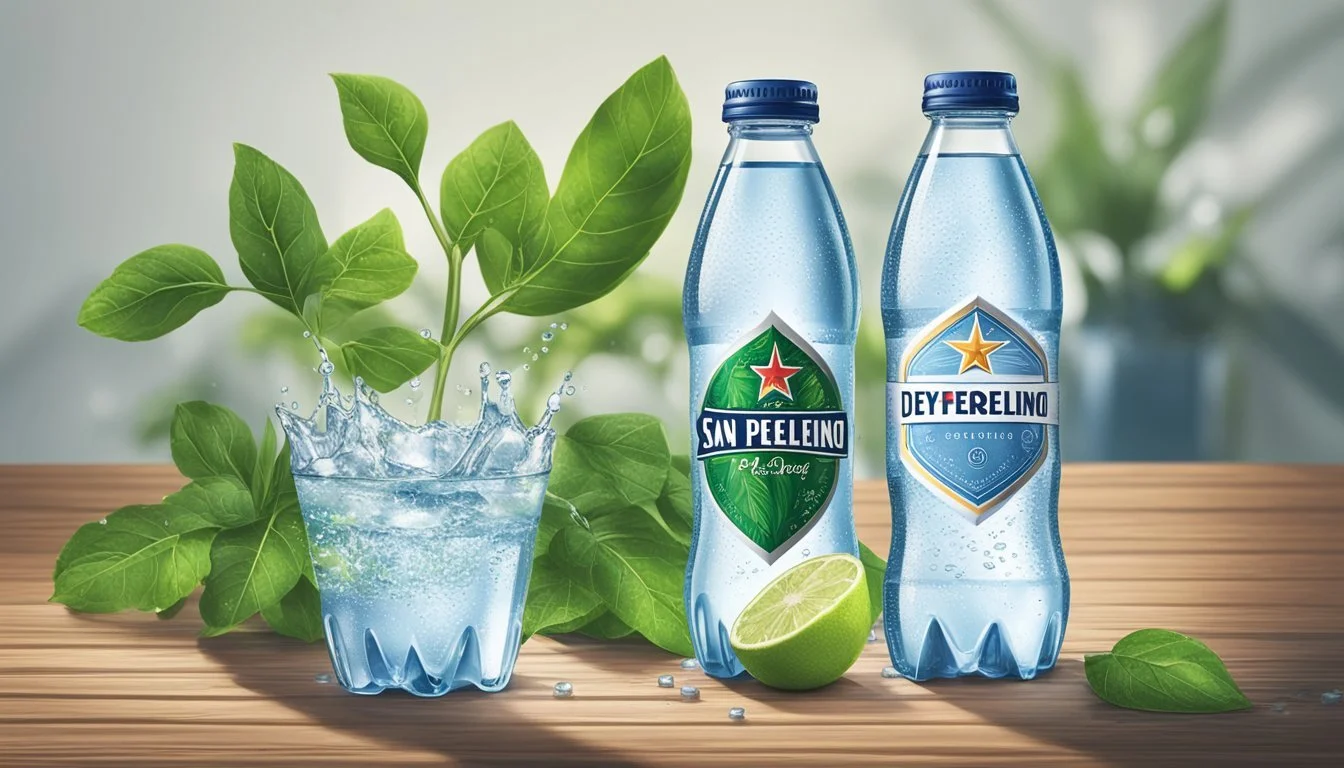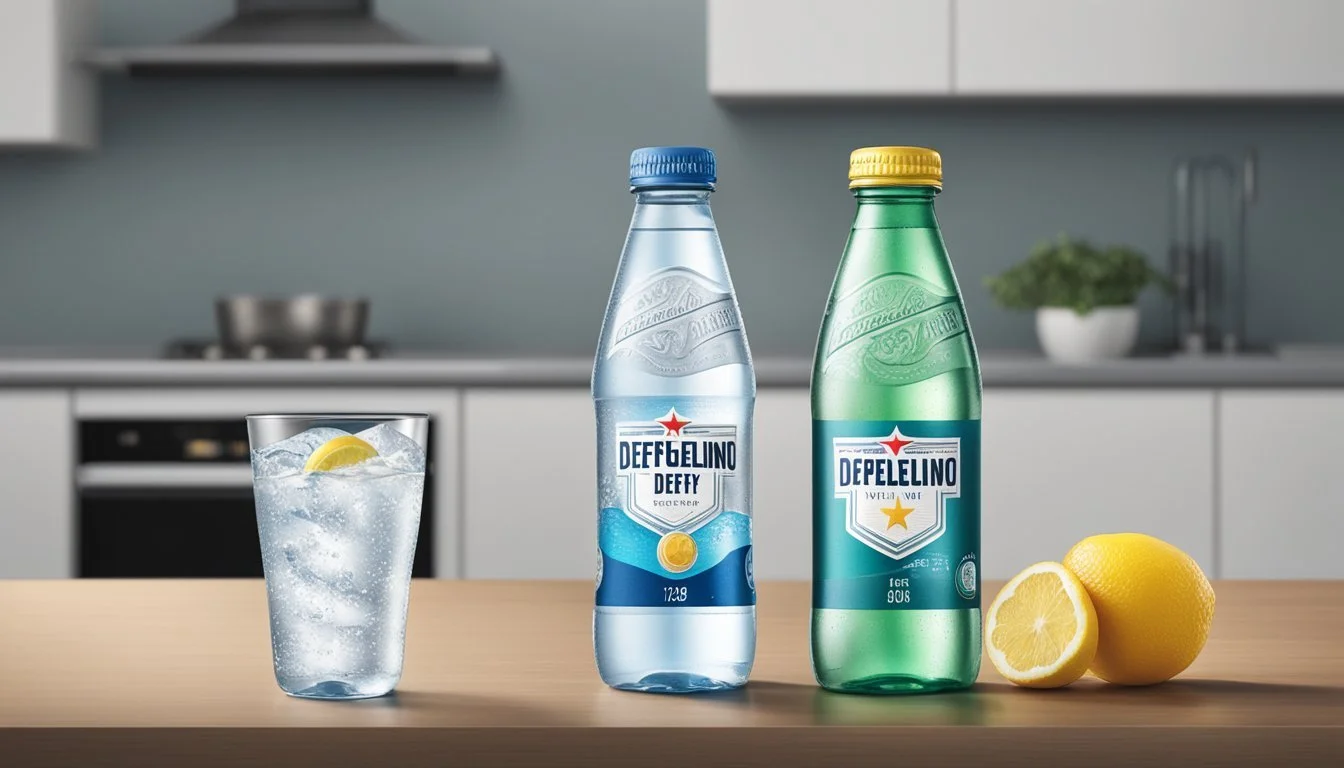San Pellegrino vs. Defy
Comparing the Best Bottled Water Brands
San Pellegrino and Defy bottled water brands stand out in the diverse world of premium hydration options. San Pellegrino, known for its slightly more pronounced fizz, often wins the favor of those who enjoy a lively and refreshing experience. San Pellegrino offers a balanced, mineral-rich profile that enhances its crispness and subtle nuances in taste.
Defy, on the other hand, champions a unique blend of purity and mineral content aimed at delivering a smooth, clean finish. It caters to consumers who appreciate a minimalist approach to bottled water without compromising on essential minerals that contribute to health and flavor. Defy’s emphasis on removing impurities while retaining vital minerals provides its water with a distinct, refined taste.
When choosing between San Pellegrino and Defy, one's preference will likely hinge on their taste and texture inclinations. Both brands bring unique qualities to the table, appealing to different palates and hydration needs. Are you craving a spirited, effervescent sip, or a smooth, mineral-rich experience?
Unveiling the Contenders: San Pellegrino and Defy
San Pellegrino stands out as a renowned brand in the world of sparkling mineral water. Sourced from the Italian Alps, this water is infused with natural minerals, such as potassium, calcium, sodium, and magnesium. Carbon dioxide is added to enhance its effervescence, giving it a distinct, vibrant fizz.
Defy is a relative newcomer to the bottled water market. Unlike San Pellegrino, Defy focuses on offering a balance between purity and taste, making it an appealing option for those seeking a less mineral-intensive water experience. While details on its specific mineral content are lesser known, Defy’s emphasis leans more towards providing clean, refreshing hydration.
Comparing the two brands highlights noticeable differences:
Feature San Pellegrino Defy Source Italian Alps Not widely publicized Mineral Content High (potassium, calcium) Lower, exact minerals unclear Carbonation Added carbon dioxide Varies based on product Taste Profile Mineral-rich, slightly salty Crisp, clean, neutral
San Pellegrino is often chosen for its rich mineral content and pronounced effervescence, making it a preferred choice for those who enjoy a distinctive, fizzy beverage.
Defy offers a contrasting appeal, likely targeting individuals who prefer a more neutral-tasting water.
In terms of packaging, San Pellegrino’s branding exudes a classic, elegant feel, while Defy opts for a modern, sleek design. Both brands cater to different consumer preferences, emphasizing various facets of bottled water enjoyment.
The Essence of Sparkling Water
Sparkling water holds a distinct charm, combining the refreshing qualities of water with effervescent character and mineral enrichment. Below, two critical aspects of sparkling water are explored: the carbonation process and the mineral content.
Carbonation Process and Bubbles
The key feature of sparkling water lies in its carbonation process, where carbon dioxide (CO₂) is added under pressure. This infusion of CO₂ creates the delicate bubbles that provide the signature fizz.
The size and persistence of these bubbles can vary depending on the brand.
Natural carbonation can occur when water passes through volcanic rocks, absorbing natural CO₂ from mineral-rich underground reservoirs. This process results in smaller, softer bubbles.
Artificial carbonation is more common and involves pumping CO₂ into water. Brands like San Pellegrino and Defy might use either method, influencing the texture and feel of the bubbles on the palate.
Mineral Content Disclosure
The mineral content in sparkling water significantly impacts its taste and health benefits. Essential minerals such as calcium, magnesium, potassium, and sodium are naturally occurring in mineral waters.
Calcium promotes bone health, while magnesium supports muscle function. Potassium helps regulate blood pressure, and sodium is crucial for hydration.
San Pellegrino, sourced from Italy, is known for its mineral-rich profile, including high levels of calcium and magnesium, giving it a slightly salty taste.
Defy, depending on its source, may offer a different mineral composition. Reading the labels for mineral salts content is vital for making an informed choice, as these minerals contribute to both flavor and nutritional value.
From Source to Sip: Origins and Production
San Pellegrino draws its sparkling mineral water from a spring in the Italian Alps, giving it a distinct taste. In contrast, Defy sources its water from specialized aquifers, each contributing unique characteristics.
San Pellegrino Terme: A Natural Spring in Italy
San Pellegrino’s journey starts in San Pellegrino Terme, a small town in the Lombardy region of Italy. The water is sourced from a natural spring located at the foothills of the Italian Alps.
This spring has been known for its purity and mineral content for centuries. Water flows through dolomite rocks, which enrich it with minerals like calcium and magnesium. The water naturally carbonates as it emerges from the spring, ensuring a unique effervescence.
The production process emphasizes maintaining the natural mineral balance. The water is bottled at the source to preserve its freshness and mineral content, offering a consistent product.
Exploring Defy Water's Source
Defy water sources its drinking water from specialized aquifers. These aquifers undergo meticulous monitoring to ensure water quality standards are met.
Unlike San Pellegrino, which has a single source, Defy's approach allows for regional flavors. Each aquifer contributes a distinct mineral profile, custom-filtered to create a balanced, pure taste. The water is purified through advanced filtration technologies, encompassing reverse osmosis and UV treatment.
This ensures that the water remains free from any contaminants while retaining essential minerals. Defy's bottling process is conducted in cutting-edge facilities designed to maintain the highest standards of hygiene and quality control.
The Role of the Italian Alps in Water Purity
The Italian Alps play a crucial role in the purity and mineral composition of San Pellegrino water. The water originates from precipitation in the mountains, which filters through limestone and dolomite rocks over 30 years.
This prolonged filtration process enriches the water with minerals like calcium, magnesium, and bicarbonate. The natural carbonation adds to the crisp and refreshing quality, setting it apart from other bottled waters.
Moreover, the remote location of the spring ensures minimal human interference, preserving the pristine quality of the water. The Alps act as a natural filter, providing sanitary drinking water with consistent mineral content.
Comparative Analysis: Taste and Texture
The taste and texture of San Pellegrino and Defy bottled water brands offer unique experiences. Differences lie in their flavor profiles and the feeling they leave on the palate.
Taste Profiles of San Pellegrino vs. Defy
San Pellegrino is renowned for its subtle mineral taste, lightly tinged with a hint of citrus. This makes it a refreshing choice that pairs well with various foods. The presence of natural minerals like calcium and magnesium contributes to its distinct flavor.
Defy water, on the other hand, boasts a clean, crisp taste that is almost neutral. It is filtered using advanced processes to remove impurities, ensuring a pure drinking experience. This lack of a strong mineral presence makes it an excellent palate cleanser.
Assessing the Mouthfeel and Effervescence
San Pellegrino’s effervescence is one of its signature features. The fine, persistent bubbles create a smooth mouthfeel that many find pleasing. The carbonation level is balanced, offering a gentle tingling sensation without overpowering the palate.
In contrast, Defy water can vary in its effervescence, often providing a more subtle fizziness. Its texture is generally smooth and unintrusive, designed to enhance rather than dominate the drinking experience. This makes Defy a versatile choice for those who prioritize hydration without the distraction of strong carbonation.
Health and Hydration
San Pellegrino and Defy offer distinct profiles in terms of minerals, hydration benefits, and impact on teeth and bone health. This section provides an insightful comparison to help you decide which brand aligns better with your health priorities.
Minerals and Their Benefits
San Pellegrino is rich in essential minerals like calcium, magnesium, and bicarbonate. These minerals support bone health, muscle function, and maintain acid-base balance in the body.
Defy boasts a unique combination of minerals, including higher amounts of potassium and electrolytes, which are crucial for heart health and maintaining fluid balance.
Minerals in both waters contribute to overall well-being and provide an additional source of needed nutrients.
Hydration and Digestion Benefits
Hydration is fundamental for bodily functions and both waters excel in this category. San Pellegrino, with its sparkling water option, may appeal to those looking for a refreshing and engaging way to increase water intake.
Defy, with its mineral-rich composition, can be particularly beneficial for digestion due to the presence of natural minerals like magnesium, which aids in digestive processes and helps prevent constipation.
Proper hydration from both brands supports kidney function, skin health, and cognitive performance.
Impact on Teeth and Bone Health
San Pellegrino, with its higher calcium content, supports bone density and teeth strength, making it a suitable choice for those focused on skeletal health. The sparkling variant should be consumed in moderation as the carbonation may affect tooth enamel over time.
Defy’s composition, while also beneficial for bones, places more emphasis on potassium and magnesium rather than calcium. This difference might appeal to individuals looking for a balance tailored to cardiovascular health and muscular function, but still supporting overall dental health with moderate consumption.
Both brands offer significant health benefits, and the choice between them can depend on your specific nutritional needs and health goals.
Variety and Versatility
When comparing San Pellegrino and Defy, their range of flavors and usefulness in culinary settings and mixology are key considerations. Each brand offers distinct options that cater to different tastes and uses.
Flavored Options and Pairings
San Pellegrino provides numerous flavored sparkling waters such as lemon, orange, grapefruit, limonata (lemonade), and clementine. These flavors are known for their crisp and refreshing taste, enhancing the drinking experience. The small and fine bubbles of San Pellegrino create a champagne-like effervescence that is enjoyed by many.
Defy, while also offering a variety of flavors including watermelon, strawberry, and pomegranate, caters more to those seeking bold and innovative flavor combinations. Both brands pair their flavored waters well with a variety of dishes. San Pellegrino, with its lighter, subtler flavors, matches excellently with Mediterranean cuisine, seafood, and light salads. Defy, with its stronger flavors, pairs well with heavier, spicier dishes, offering a refreshing counterbalance.
Culinary Compatibility and Use in Mixology
In addition to being enjoyed on their own, both San Pellegrino and Defy waters are popular in culinary and mixology circles. San Pellegrino’s mineral profile and balanced flavors make it an ideal choice for food and wine pairings. Its clementine and grapefruit flavors enhance the taste of fish dishes and citrus-based desserts. Chefs often prefer its refined bubbles, which do not overpower delicate food flavors.
Defy’s flavored waters, such as pomegranate and watermelon, are popular in cocktail recipes. Mixologists use them to create unique and flavorful drinks, adding an innovative twist to traditional beverages. The boldness of Defy's flavors enhances cocktails like mojitos, spritzers, and punches, providing a distinctive taste that stands out.
Both brands bring variety and versatility to beverages and cuisine, each excelling in their unique strengths catering to different preferences and culinary applications.
Environmental and Sustainability Insights
San Pellegrino and Defy both have unique approaches to addressing their environmental impacts and implementing sustainable practices.
Environmental Impact of Bottled Water
The production of bottled water involves significant environmental considerations. San Pellegrino uses PET plastic for its bottles, known for being recyclable. However, the bottling process, packaging materials, and transportation contribute to a substantial carbon footprint. Ethos, mentioned earlier, and other competitors face similar challenges.
By contrast, Defy, a brand known for its minimalist design, focuses on using eco-friendly packaging. The company employs biodegradable materials to minimize environmental harm. Reducing plastic usage and encouraging customers to recycle are central to Defy’s strategy.
Sustainability Efforts and Practices
San Pellegrino is committed to sustainability. The brand pledges to achieve carbon neutrality. This includes reducing emissions across its operations, from production to distribution. San Pellegrino has set up initiatives aiming for sustainable water management and reducing plastic waste.
On the other hand, Defy employs a different strategy. It emphasizes sustainable sourcing and renewable energy in its manufacturing processes. Defy actively partners with environmental organizations to support conservation projects. This collaboration enhances its impact and aligns with broader sustainability goals.
Both brands show a commitment to sustainability through various efforts, addressing both environmental impact and sustainable practices in their operations.
The Market Landscape
San Pellegrino and Defy operate in a competitive bottled water market characterized by varied consumer preferences and distinct industry trends. Pricing and availability also play crucial roles in shaping the choices of consumers.
Consumer Preferences and Industry Trends
Consumers increasingly seek premium bottled water for its perceived quality and taste. San Pellegrino, known for its sparkling water, attracts those desiring a unique mineral composition and carbonation. Defy caters to a different segment, often emphasizing purity and innovative packaging.
Industry trends show a growing demand for health-conscious products. Functional waters, including mineral and alkaline water, are on the rise. Both brands respond to environmental concerns by exploring sustainable practices.
San Pellegrino enjoys a strong market presence, attributed to its Italian heritage and brand loyalty. Defy's marketing focuses on innovation and disruption, appealing to younger demographics seeking differentiation.
Pricing and Availability
Pricing strategies for bottled water vary, with premium brands like San Pellegrino often positioned at higher price points due to their quality and brand reputation. Defy tends to offer competitive pricing with emphasis on value for money.
Availability is crucial. San Pellegrino benefits from a well-established distribution network, present in supermarkets, restaurants, and online platforms. Defy's distribution may be more niche, leveraging digital platforms and specialty stores for targeted consumer engagement.
The market share of San Pellegrino is robust, bolstered by its global reach and consistent sales. Defy, while newer, gains traction through distinct marketing campaigns and strategic pricing. The balance between price, availability, and consumer preference continues to shape their competitive landscape.
More About San Pellegrino
Acqua Panna vs San Pellegrino: Which Bottled Water is Better?
Boxed Water vs San Pellegrino: Which Bottled Water is Better?
Core Hydration vs San Pellegrino: Which Bottled Water is Better?
Ice Mountain vs San Pellegrino: Which Bottled Water is Better?
Icelandic Glacial vs San Pellegrino: Which Bottled Water is Better?
Just Water vs San Pellegrino: Which Bottled Water is Better?
Mountain Valley Spring Water vs San Pellegrino: Which Bottled Water is Better?
Nestle Pure Life vs San Pellegrino: Which Bottled Water is Better?
Poland Spring vs San Pellegrino: Which Bottled Water is Better?
San Pellegrino vs Alkaline88: Which Bottled Water is Better?
San Pellegrino vs Aqua Carpatica: Which Bottled Water is Better?
San Pellegrino vs Cascade Mountain: Which Bottled Water is Better?
San Pellegrino vs Castle Rock: Which Bottled Water is Better?
San Pellegrino vs CBD Living: Which Bottled Water is Better?
San Pellegrino vs Crystal Geyser: Which Bottled Water is Better?
San Pellegrino vs Crystal Lake: Which Bottled Water is Better?
San Pellegrino vs Essence pH10: Which Bottled Water is Better?
San Pellegrino vs Hawaii Volcanic: Which Bottled Water is Better?
San Pellegrino vs Hawaiian Springs: Which Bottled Water is Better?
San Pellegrino vs Kirkland Signature: Which Bottled Water is Better?
San Pellegrino vs Liquid Death: Which Bottled Water is Better?
San Pellegrino vs Open Water: Which Bottled Water is Better?
San Pellegrino vs Proud Source: Which Bottled Water is Better?
San Pellegrino vs Purely Sedona: Which Bottled Water is Better?
San Pellegrino vs Richard's Rainwater: Which Bottled Water is Better?
San Pellegrino vs Simple Truth: Which Bottled Water is Better?
San Pellegrino vs Smartwater: Which Bottled Water is Better?
San Pellegrino vs Solan de Cabras: Which Bottled Water is Better?
San Pellegrino vs Talking Rain AQA: Which Bottled Water is Better?
San Pellegrino vs Topo Chico: Which Bottled Water is Better?
San Pellegrino vs Weird Water: Which Bottled Water is Better?
San Pellegrino vs Whole Foods 365: Which Bottled Water is Better?
San Pellegrino vs Whole Foods Italian Still Mineral water: Which Bottled Water is Better?
San Pellegrino vs Zephyrhills: Which Bottled Water is Better?





